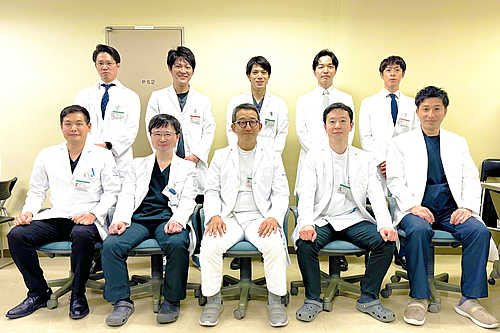




 The Kobe University Orthopaedic Spine Surgery division has three faculties, four graduate school students, and residents. In our hospital, we treat severe complicated spinal diseases, including tumors, scoliosis, and osteoporosis-associated spinal deformities, working together with anesthesiologists, cardiologists, pediatricians, radiologists, physiatrists, and co-medical staffs. We attempted to find the best treatment strategy based on each patient's disease, condition, and activity.
The Kobe University Orthopaedic Spine Surgery division has three faculties, four graduate school students, and residents. In our hospital, we treat severe complicated spinal diseases, including tumors, scoliosis, and osteoporosis-associated spinal deformities, working together with anesthesiologists, cardiologists, pediatricians, radiologists, physiatrists, and co-medical staffs. We attempted to find the best treatment strategy based on each patient's disease, condition, and activity.
Recently, the number of our surgical cases is increasing up to approximately 300 cases/year, closely cooperating with neighboring hospitals. This enables us to treat more patients surgically without long-period waiting. We all continue to take on new challenges to rescue many patients with spinal problems by optimal treatments.
We are consistently conducting basic research for intervertebral disc pathology. Our primary focus is to reveal the mechanism of disc diseases and to provide insights into new biological therapy.
Biological treatments of disc degeneration
The intervertebral disc a unique structure consisting of the nucleus pulposus encapsulated by the annulus fibrosus and endplates. The disc is the largest avascular organ in the body. Therefore, additional nutrient deprivation associated with injury, smoking, and/or aging is a suspected contributor to disc degeneration. We studied biological agents, peptides, and proteins to reduce cellular stress based on the anatomical characteristics and limited nutrition of the disc-SIRT1 (Arthritis Res Ther, 2011, 2015), integrin antagonists (Spine J, 2015), and adiponectin (J Orthop Surg Res, 2016). We are testing these treatments in vivo for future clinical trials.
Animal models of disc degeneration
To study the disease mechanism and assess effects of new biological treatments, the development of animal models is essential. Mechanical loading is a major induction method to disc degeneration. To mimic human spontaneous chronic disc degeneration, we developed and reported a rat tail model of disc degeneration induced by sustained static compression (J Orthop Res, 2010, 2011, Arthritis Res Ther 2012, 2014). Furthermore, a modified version of this model, better suited to observe earlier events of disc degeneration, was also established (J Orthop Res 2014) and awarded the Best Basic Research Paper Award at the 120th and meeting of the Central Japan Association of Orthopaedic Surgery and Traumatology (Wakayama, 2013). We have developed an ex-vivo dynamic compression model (Spine J, 2015) more recently in collaboration with Rush University (Chicago, IL, USA), University of California San Diego (San Diego, CA, USA), and Doshisha University (Kyoto, Japan). These animal models will facilitate the future development of molecular treatments for disc disorders.
Disc herniation and immune privilege
We proposed the disc as an immune-privileged site based on the anatomical feature and also the expression of apoptosis-inducing Fas ligand in the nucleus pulposus (Spine [Phila Pa 1976], 2002, 2004). We further clarified the interaction between the nucleus pulposus and macrophages in an animal model of herniated discs (Arthritis Rheum, 2012). Evidence regarding Fas ligand and macrophage infiltration can provide useful information to understand the pathophysiology of herniated disc disease. We are conducting new studies to develop biological treatments.




